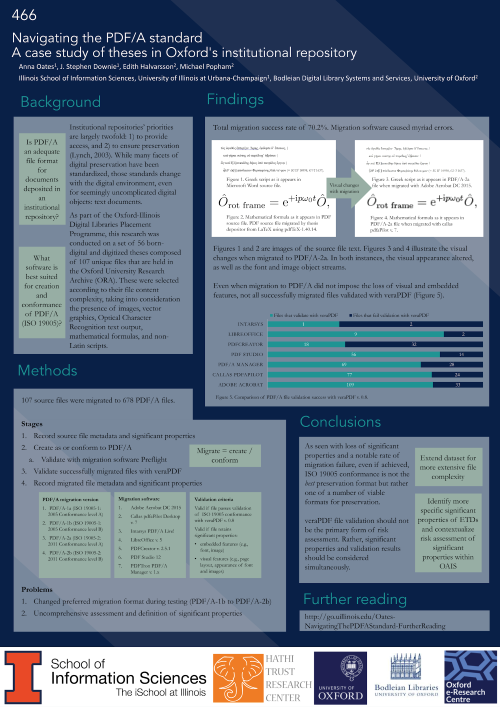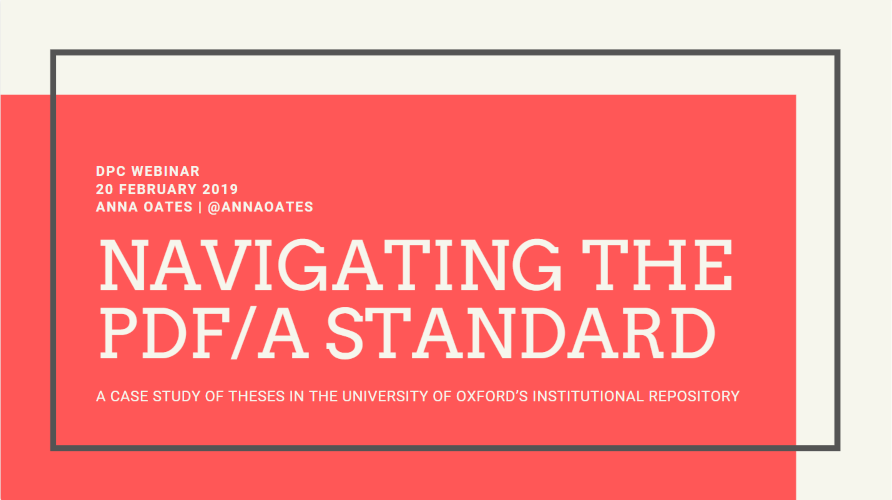Anna Oates is Scholarly Communication and Discovery Services Librarian at Federal Reserve Bank of St. Louis in the USA, and former graduate student of the Illinois School of Information Sciences where these studies originated.
A Roundabout Introduction to Digital Preservation of Dance: Navigating the PDF/A Standard
Four months after its initial submission, my master's thesis [1] appeared on the University of Illinois at Urbana-Champaign institutional repository. Since this successful ingest, I have been asked to write a brief summary so that those who might find value in the research would not have to traverse through the pages of a laborious discussion on PDF, specifically as manifested in PDF/A (Portable Document Format — Archival) as a recommended format for the long-term preservation of student theses and dissertations. True to the Galleries, Libraries, Archives, and Museums (GLAM) quiddity, my research explored the meta relationship of my student work — a thesis to be deposited in an institutional repository about theses that had been deposited in an institutional repository.
My research may be of interest to those who brave the onerous task of reading extensive research on the topic of PDF/A as it relates to digital preservation. Ancillary to the discussion which exposed the necessity for institutions to be aware of their content and the containers in which they store the content — see more on non-Latin glyphs, image interpolation, and compression algorithms in my thesis [1] — was the underpinning inquiry as to why this evaluation and conversation is requisite to digital preservation of student scholarship: What are the sociotechnical implications and restrictions of digital preservation systems and the policies that support those systems?
If you can accept eschewing the history of the PDF universe and additional cases of PDF/A conundrums, contextualized in sociotechnical and authenticity challenges, see my iConference 2018 abstract [2] and poster (figure 1). If you find that you need to revel in the research a little longer, you can view a webinar [3] on “Navigating the PDF/A Standard” and follow along with the slides (figure 2).

Figure 1. iConference 2018 poster on “Navigating the PDF/A standard: A case study of theses in Oxford’s institutional repository.”
Figure 2. Navigating the PDF/A Standard [slide deck].
Retrieved from https://www.canva.com/design/DADR4YL5stU/nM679vpvx2cF4Fl4-BdqbA/view?utm_content=DADR4YL5stU&utm_campaign=designshare&utm_medium=link&utm_source=sharebutton
By way of that contextual introduction, I now explore the sociotechnical discussion of digital preservation in a verily divergent context. Through a series of observations and inquiries, I build upon this conversation in the context of community archiving for performing arts, entering a world that emerged before and burgeoned throughout my graduate studies: preservation of dance.
Digital Preservation of Contemporary and Modern Dance
Persistent across literature on dance archiving and acknowledged in UNESCO’s initiatives toward the preservation of intangible cultural heritage, dance is a temporal and spatial form that cannot be accurately preserved. While accepting the impossibility to capture temporal, spatial, and experiential media art, Julia Hudson [4] argues the necessity for a digital simulacrum, which might be used to re-experience or re-use dance as collected and curated in an archive. In this context, digital simulacra is a byproduct that embodies the transient performance as a wholly separate, metastable entity that serves as a de-scription of the original performance [5]. Such digital simulacra are born in varying degrees of documentation and capture of dance materials across digital archives. Three case studies of digital archives for contemporary and modern dance are represented in the Siobhan Davies Dance archive, Renée Wadleigh’s Digital Library, and the Jacob’s Pillow Archives.
The Siobhan Davies Dance archive, RePlay “[contains] thousands of fully searchable digital records of [the company’s] choreographic work, including film footage, images, audio and text” [6]. This resource is born of the dance company and consists of documentation of that company. In conjunction with the main website, RePlay exhibits every aspect of the company from the studio space and company classes to metadata records and openly available media of the performances.
Throughout her career, Renée Wadleigh, an emeritus professor of the Fine and Applied Arts Dance at Illinois program of the University of Illinois at Urbana-Champaign has collected “video documentation of dance works created by living choreographers for the last 25 years” [8]. This collection, made available through her Digital Library, “allows [the dance community] to weave a woefully undocumented sector of dance history back into a larger view of post-modern and contemporary dance” [8].
Similar to Wadleigh’s Digital Library in its collection scope, the Jacob’s Pillow Archives documents content produced by decades of artists through a “collection of moving images, books, correspondence and other materials” [10].
Despite the reference to “archive” in name or form, the access platforms do not discuss the role of digital preservation for long-term sustainability of and access to the digital objects. Indeed, “Preservation is meaningless without access” [11], but access cannot be sustained without preservation.
The Dance Heritage Coalition (DHC) offers community resources to support dance preservation, focusing on common issues specific to analog mediums for recording dance (e.g., magnetic tape) and documentation for discovery of collections through finding aids. In addition to providing community resources, the DHC hosts a discovery platform that aggregates DHC-member finding aids. While aggregation does enable increased discovery of content across collections, the DHC’s work does not support the preservation of born digital objects or digitized objects for which there is no analog medium.
With dynamic modals for performance creation (e.g., 3D motion capture and motion tracking), contemporary dance companies, such as Chunky Move, create complex digital works that, if permitted by the choreographer or company, may be disseminated for streaming. Unless disseminated on a content discovery platform [15], works are not curated as complete digital objects with descriptive metadata or associated media, and are not stored in a sustainable environment for long-term preservation.
<iframe width="560" height="315" src="https://www.youtube.com/embed/2AautwIOON8?start=432" frameborder="0" allow="accelerometer; autoplay; encrypted-media; gyroscope; picture-in-picture" allowfullscreen></iframe>
Contemporary Dance: Chunky Move | GLOW. Retrieved from https://youtu.be/2AautwIOON8
Dance presents the digital preservation community with unique challenges that test the understanding of traditional preservation theory and practice. Digital preservation professionals must analyze efforts both past and present, and ask how the community can expand our current understanding of digital content collection, management, and access to facilitate continued connection to dance.
References
[1] Oates, A.I. (2018). Navigating the PDF/A standard: a case study of theses in the University of Oxford’s institutional repository. (Master’s thesis, University of Illinois at Urbana-Champaign). http://hdl.handle.net/2142/100913
[2] Oates, A., Downie, J.S., Halvarsson, E. & Popham, M. (2018, March). Navigating the PDF/A standard: A case study of theses in Oxford’s institutional repository. Poster presented at iConference 2018, Sheffield, UK. http://hdl.handle.net/2142/100236
[3] Digital Preservation Coalition (Producer). (2019, Feb.) Navigating the PDF/A standard [Video webinar]. Retrieved from https://youtu.be/h7RHAOivTec
Oates, A. (2019, Feb.) Navigating the PDF/A Standard [Slide deck]. Retrieved from https://www.canva.com/design/DADR4YL5stU/nM679vpvx2cF4Fl4-BdqbA/view?utm_content=DADR4YL5stU&utm_campaign=designshare&utm_medium=link&utm_source=sharebutton
[4] Hudson, J. (2012). Access and collective memory in online dance archives. Journal of Media Practice, 13(3), 285–301. https://doi.org/10.1386/jmpr.13.3.285_1
[5] Akrich, M. The de-scription of technical objects. In W. E. Bijker & J. Law (Eds.),
Shaping technology/building society: Studies in sociotechnical change (Cambridge, MA: MIT Press 1992).
[6] Siobhan Davies Dance. (n.d.). Retrieved from https://www.siobhandavies.com
[7] Siobhan Davies RePlay: The Choreographic Archive of Siobhan Davies Dance. (n.d.). Retrieved from https://www.siobhandaviesreplay.com/
[8] O’Connor, T. (n.d.). Renée Wadleigh. Retrieved from http://reneewadleigh.com
[9] Renée Wadleigh Digital Library. (n.d.). Retrieved from http://reneewadleigh.com/digital-library-2/
[10] Jacob’s Pillow Archives. (2019). Retrieved from https://archives.jacobspillow.org
[11] @SusanKing. (2019, Feb. 14). “Preservation is meaningless without access. —Julian Morley of Stanford #pasig2019 #digipres” [Twitter Post]. Retrieved from https://twitter.com/SusanKung/status/1096145985884033025
[12] Preservation. (n.d.). Dance Heritage Coalition (archived site). Retrieved from http://new.danceheritage.org/html_OLD/preservation/
[13] Dance Heritage Coalition (2014). Retrieved from http://findingaids.danceheritage.org
[14] XTF: Results (Dance Heritage Coalition discovery interface). (n.d.). Retrieved from: http://findingaids.danceheritage.org/xtf/search
[15] Chunky Move. (n.d.). Retrieved from http://chunkymove.com
[15] See The Merce Cunningham Dance Capsules. (2012). Retrieved from https://dancecapsules.mercecunningham.org/











































































































































